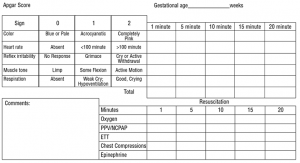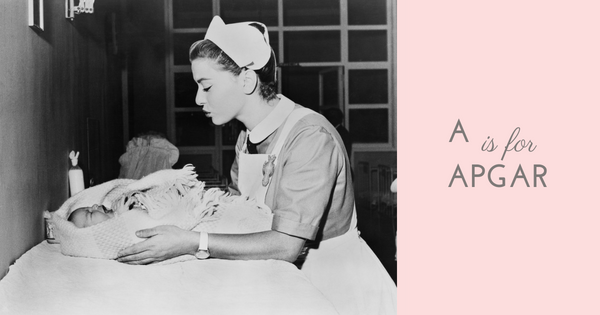In the delivery room as your baby’s birth becomes more imminent, a nurse will come in who’s sole responsibility is your baby. Immediately after your baby is born, this nurse will assess your baby in five areas. Unlike other newborn procedures your baby may undergo, this is non-invasive. I’m talking about the APGAR Score.
What is the APGAR Score?
Dr. Virginia Apgar, an anesthesiologist, developed the APGAR Score in 1952. Your doctor will score your baby at one minutes of age to see how they tolerated the birthing process and how they are adjusting to life outside the womb. Doctors originally used this rubric to quantify the effects of anesthesia on the baby.
The doctor will look at your baby’s Appearance, Pulse, Grimace, Activity, and Respiration. They will score your baby from 0-2 for each category. Your doctor will use these scores to ascertain if special care is needed. The APGAR score is is not a predictor of neurological outcomes; it’s purpose is strictly to look at the need for, and response to, resuscitation.
How does the doctor score my baby?

Scoring is based on their physical appearance and reactions. While 10 is the highest score, very few babies get it. This is because the extremities of most babies do not appear the same color as their core immediately after birth.
Scores between 7 and 10 are considered “normal”. Scores from 4 to 6 indicate that some assistance may be required, and scores below 4 call for immediate lifesaving measures.
The medical team will repeat the assessment again at 5 minutes of life. If your baby scores below 7 at the 5 minute assessment, the medical staff will continue to score your baby at 5 minute intervals.
Maternal sedation, gestational age, trauma, and observer variability can influence an APGAR score. Your baby’s initial score may be low if the pregnancy was high risk, labor was difficult, baby was born prematurely. or if the mother was given an epidural (or other sedation).
Lower than “average” scores do not mean there will be permanent health problems, especially if there is improvement in your baby’s score with time. Low scores indicate that further care or resuscitation may be needed.
It is important to remember that most providers do not consider the APGAR to be perfect. This is mainly due to observer variability (one observer may rate a response 6 and another 7). When used in conjunction with other assessments, APGAR scores provide a complete picture of baby’s adjustment to life outside the womb.
Additional Readings
B is for Bishop Score
C is for Car Seats
D is for Delayed Cord Clamping
This blog is for informational purposes only. It should not take the place of consultation with your healthcare professional.

